10 Key Differences Between Queen vs Monarch Butterfly Chrysalises
A printable Monarch butterfly life cycle diagram provides a detailed overview of each developmental stage from egg to adult. Each pale cream-colored egg measures approximately 1.2 mm in diameter and hatches into a larva measuring 2-3 mm, which grows to about 45 mm through five instars.
The pupal stage showcases a chrysalis around 2.5 cm long, with adult butterflies emerging with a wingspan of 9-10 cm. High-resolution images and precise annotations illustrate these stages and morphological transformations, making them invaluable for educators and researchers seeking to trace the intricate process of metamorphosis.
Download these resources to explore deeper insights.
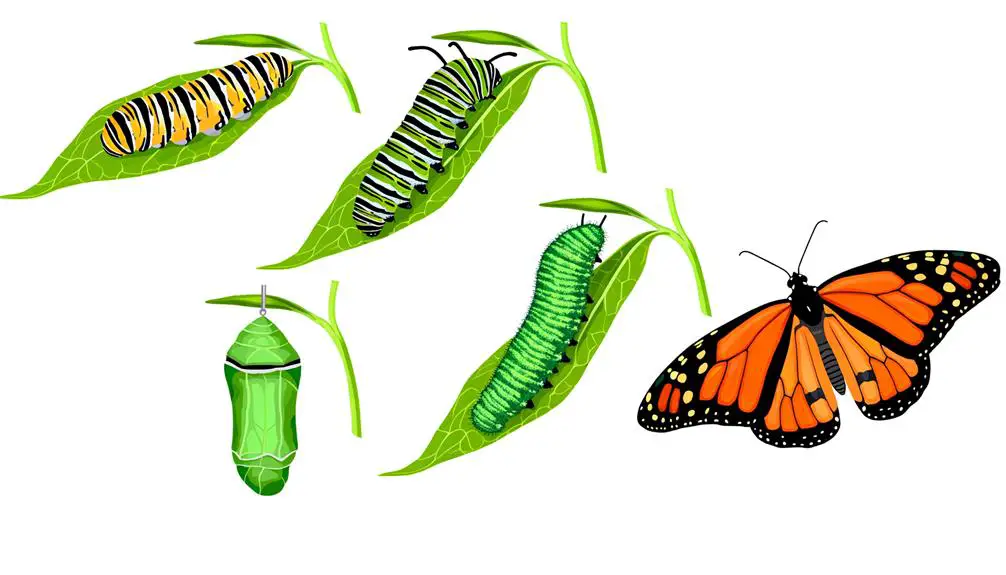
Key Takeaways
- High-resolution diagrams detail the four primary life cycle stages: egg, larva, pupa, and adult.
- Printable guides illustrate morphological changes with precise measurements and annotations.
- Educational tools support autonomous study of monarch metamorphosis.
- Resources include visual aids for understanding monarch population dynamics and reproductive behaviors.
Egg Stage
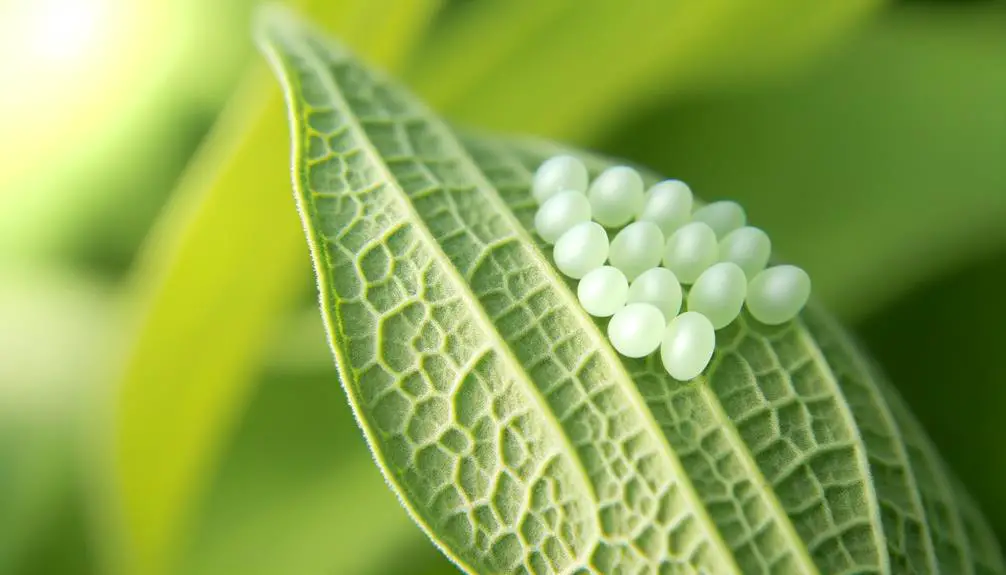
The egg stage of the Monarch butterfly (Danaus plexippus) lifecycle commences when an adult female deposits a single, pale cream-colored egg, approximately 1.2 millimeters in diameter, on the underside of a milkweed leaf (Asclepias spp.). This strategic placement maximizes access to essential nutrients required for larval development.
The egg's elliptical shape and ribbed texture enhance structural integrity and facilitate adhesion to the leaf surface. Within this diminutive capsule, embryogenesis proceeds, orchestrated by a suite of genetic instructions. The chorion, an outer shell, safeguards the developing embryo from environmental adversities and pathogens.
Observations indicate that egg morphology remains consistent across populations, underscoring evolutionary stability. Consequently, the egg stage represents a critical, foundational phase in the Monarch's complex lifecycle.
Hatching Process
Upon completion of embryogenesis, the Monarch butterfly larva initiates the hatching process by secreting enzymes to soften the chorion, facilitating its emergence. This biochemical action degrades the protective outer layer of the egg, a structure approximately 0.9 mm in diameter.
The larva uses its mandibles to create an escape hole, meticulously enlarging it until it can fully emerge. The entire process, from initial breach to full emergence, spans approximately 30-60 minutes.
Post-emergence, the newly hatched larva, measuring roughly 2-3 mm in length, typically consumes the remaining chorion. This behavior not only provides essential nutrients but also minimizes predation risk by eliminating evidence of its presence.
Precision in the hatching process exemplifies the Monarch's adaptation for survival.
Larval Stage
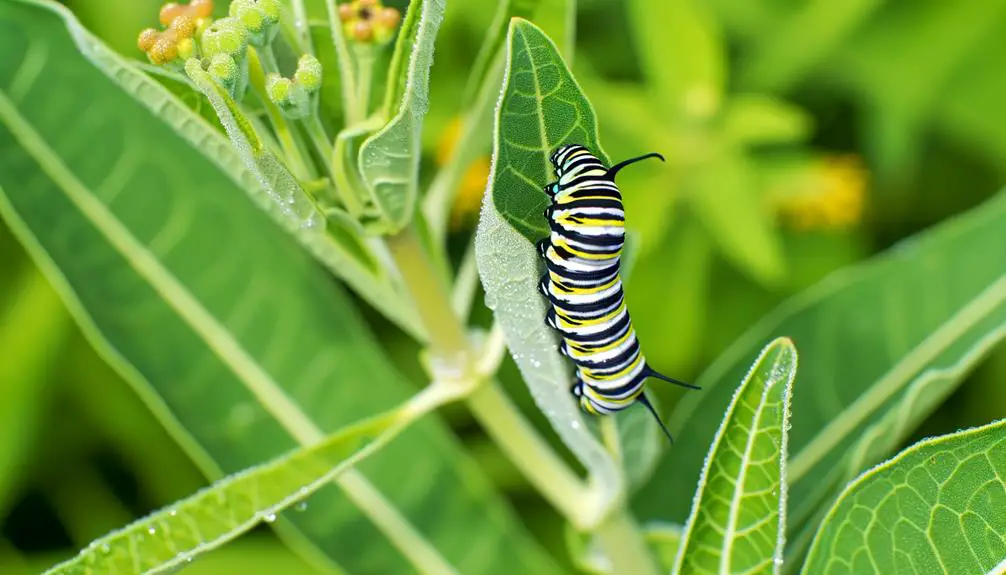
The larval stage of the Monarch butterfly, also known as the caterpillar stage, is characterized by distinct growth phases called instars.
During this period, the caterpillar undergoes five instar changes, each marked by molting and a significant increase in size.
Precise measurements indicate that the caterpillar's length increases from approximately 2 millimeters to about 45 millimeters by the final instar.
Caterpillar Growth Stages
During the larval stage, monarch caterpillars undergo five distinct instars, each characterized by significant growth and molting.
Beginning as tiny hatchlings measuring approximately 2-6 mm, they progress through stages marked by exponential increases in size. By the fifth instar, caterpillars can reach lengths up to 45 mm.
This growth is facilitated by their voracious consumption of milkweed, their sole food source, which provides essential nutrients and toxins that deter predators.
Notable morphological changes include the development of vibrant yellow, black, and white banding patterns and enhanced mandible structures for efficient feeding.
Precise observations reveal that each instar shift involves critical physiological adaptations, ensuring the caterpillar's survival and successful metamorphosis into the next life stage.
Molting and Instar Changes
Molting in monarch caterpillars signifies a critical phase where the larva sheds its exoskeleton, facilitating progression through the five instar stages. Each instar represents a distinct developmental phase, marked by increased size and morphological changes. The molting process is initiated by the release of ecdysone hormone, triggering the separation of the old cuticle and the formation of a new, larger one. Precise measurements indicate the caterpillar grows approximately 2 mm with each successive instar.
| Instar Stage | Approximate Length (mm) |
|---|---|
| First Instar | 2-6 |
| Second Instar | 6-9 |
| Third Instar | 9-14 |
| Fourth Instar | 14-25 |
| Fifth Instar | 25-45 |
These periodic molts empower the larva to attain the critical mass necessary for pupation, ensuring its successful transformation into a butterfly.
Molting Phases
Each molting phase in the monarch butterfly's life cycle, known as an instar, is characterized by specific morphological changes and precise timing.
The monarch undergoes five distinct instars, each lasting between 2 to 5 days, depending on environmental conditions. During each instar, the caterpillar increases in size, necessitating the shedding of its exoskeleton.
This process, termed ecdysis, is facilitated by the secretion of ecdysone hormone, which triggers the detachment of the old cuticle. Observations indicate that post-molt caterpillars exhibit increased pigmentation and segmental differentiation.
Measurements reveal that larvae grow approximately 2 mm in length per instar. Detailed scrutiny of these phases underscores the intricate physiological processes that enable the caterpillar to progress toward pupation.
Caterpillar Growth
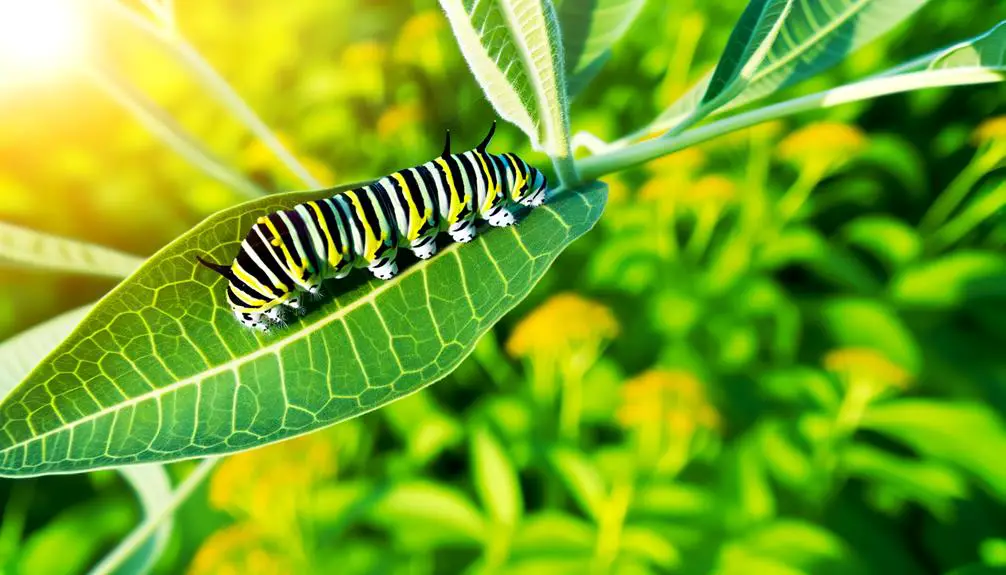
Caterpillar growth in monarch butterflies is marked by a substantial increase in biomass, with larvae gaining approximately 2 grams in weight over the course of their developmental stages.
Beginning as minute hatchlings weighing around 0.5 milligrams, monarch caterpillars undergo five instars, each marked by significant feeding and molting.
During these stages, they consume milkweed leaves voraciously, their sole food source, which provides essential nutrients like cardenolides.
Detailed observations reveal that caterpillars can grow up to 45 millimeters in length by the fifth instar.
This rapid growth is facilitated by efficient digestive and metabolic processes, enabling the larvae to convert ingested plant material into body mass.
Such growth is critical for their eventual metamorphosis into pupae.
Pupal Stage
After reaching the end of the fifth instar, the monarch caterpillar enters the pupal stage, characterized by the formation of a chrysalis where profound morphological transformations occur.
The chrysalis, initially soft and pale green, measures approximately 2.5 centimeters in length and 1 centimeter in diameter.
Over the ensuing 8-15 days, the chrysalis undergoes significant biochemical and structural changes, including histolysis of larval tissues and histogenesis of adult structures.
Enzymatic processes dismantle caterpillar cells, while imaginal discs differentiate into butterfly wings, legs, and antennae.
The outer cuticle hardens and turns a jade-green hue, adorned with metallic gold spots, which are believed to play roles in camouflage and thermoregulation.
This stage epitomizes the intrinsic drive for metamorphosis and liberation inherent in the monarch's lifecycle.
Emergence
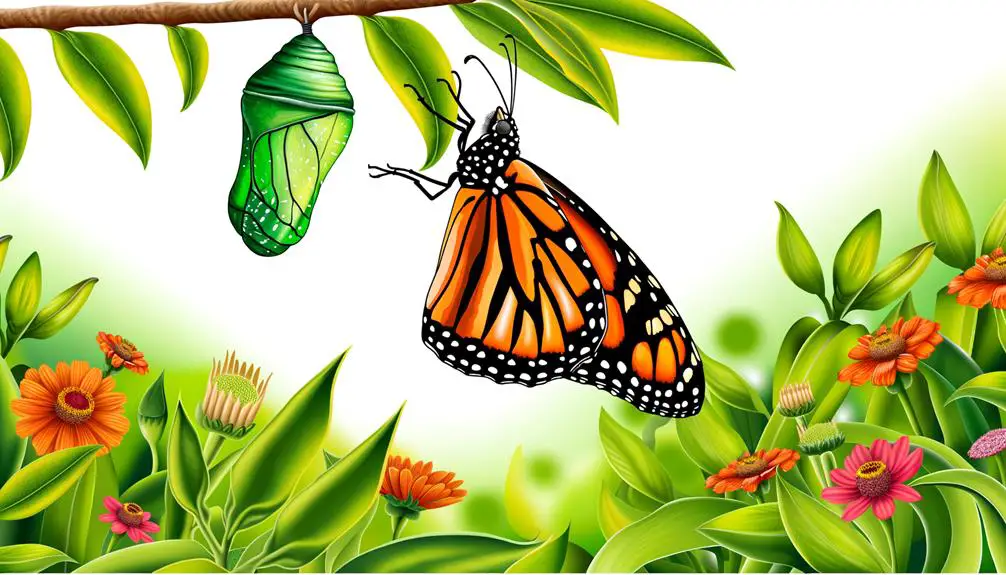
The emergence of the adult monarch butterfly, a process known as eclosion, occurs when the fully formed butterfly breaks free from the now-translucent chrysalis, typically taking place over a span of several minutes.
Initially, the butterfly uses its legs to push against the chrysalis casing, creating a split through which it can escape.
Upon emergence, the wings appear crumpled and soft, requiring approximately 30 minutes to several hours to fully expand and harden.
Hemolymph is pumped into the veins of the wings, facilitating their expansion to a span of about 9–10 cm.
During this critical period, the butterfly remains vulnerable to environmental factors and predators, underscoring the importance of rapid and efficient eclosion for survival and subsequent flight.
Adult Butterfly
Upon reaching the adult stage, Monarch butterflies exhibit highly distinctive wing patterns characterized by orange and black coloration with white spots. These patterns serve an essential role in predator deterrence through aposematic signaling.
Reproductive behavior commences shortly after emergence, with mating typically occurring within the first five days of adult life.
Females can lay between 100 to 300 eggs over their lifespan, directly influencing population dynamics and migration patterns.
Wing Pattern Significance
Intricate wing patterns in adult monarch butterflies serve multifaceted roles, including camouflage, mate attraction, and thermoregulation.
The distinct orange and black coloration functions as aposematic signaling, deterring predators by indicating toxicity acquired from milkweed ingestion.
Detailed observations reveal that the wing scales' microstructure enhances UV reflection, essential for intraspecific communication.
Precise measurements show that darker pigmentation aids in solar absorption, facilitating thermoregulation critical for flight muscle function.
The venation pattern, unique to each individual, contributes to structural integrity and aerodynamic efficiency.
These patterns also enable field researchers to conduct population studies through mark-recapture methods, enhancing our understanding of migration dynamics.
Consequently, the monarch's wing patterns embody both survival mechanisms and scientific insight.
Reproduction and Mating
Reproductive strategies in adult monarch butterflies encompass intricate courtship behaviors and precise timing, ensuring successful fertilization and continuation of the species.
Male monarchs initiate the mating process through a series of distinctive flight patterns, often involving rapid chases and aerial displays. Upon successful capture, the male transfers a spermatophore to the female, containing both sperm and nutrients, via his claspers. This process typically occurs in late summer or early fall, optimizing reproductive success.
Females then store the sperm in their reproductive tract, using it to fertilize eggs over several weeks. Each female can lay up to 400 eggs on milkweed plants, favoring those with high cardenolide concentrations, which provide essential chemical protection to the developing larvae.
Printable Resources
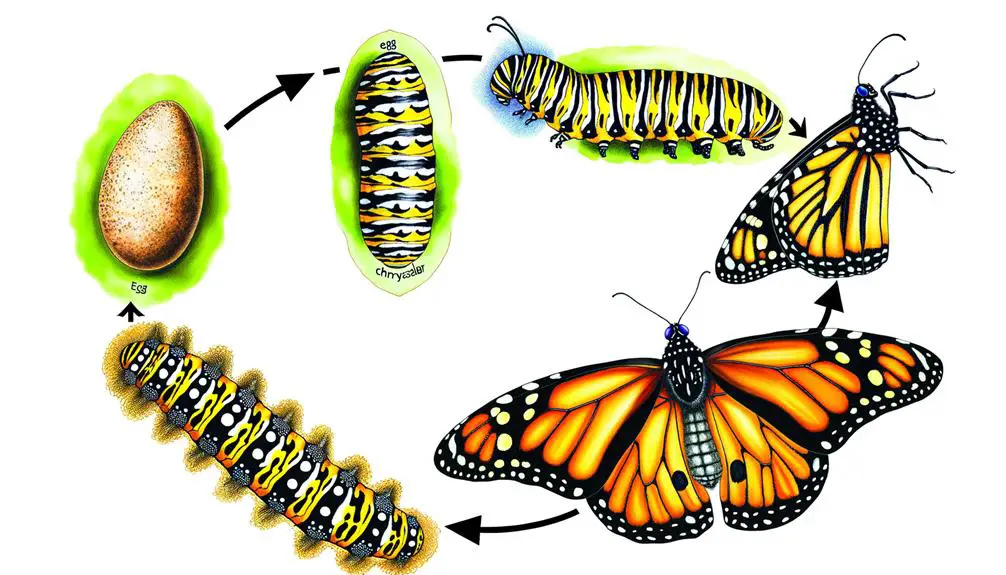
Printable resources provide detailed diagrams and step-by-step guides to enhance the understanding of the Monarch butterfly life cycle through visual aids.
These resources typically include high-resolution images detailing the four primary stages: egg (approximately 0.9 to 1.2 mm), larva (caterpillar, reaching up to 45 mm), pupa (chrysalis, about 25 mm), and adult butterfly (wingspan of 93-105 mm).
Each stage is meticulously illustrated to highlight the morphological changes, offering precise measurements and annotations.
These educational tools are indispensable for educators, researchers, and enthusiasts seeking an in-depth comprehension of metamorphosis.
Additionally, printable resources can be easily distributed, facilitating a broader reach and enabling individuals to study at their own pace, fostering a sense of autonomy in learning.
Conclusion
To summarize, the monarch butterfly life cycle, from egg stage through to adult emergence, epitomizes the adage, 'Nature's course must be run.'
Detailed observations reveal that each phase—egg, larval with its molting phases, caterpillar growth, pupal, and adult butterfly—demonstrates precise biological processes essential for metamorphosis.
These stages, meticulously documented and measured, underscore the intricate and cyclical nature of lepidopteran development.
Printable resources facilitate deeper understanding and educational dissemination of this remarkable transformation.






